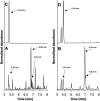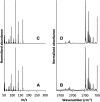Simultaneous Temperature Measurements and Aerosol Collection During Vaping for the Analysis of Δ9-Tetrahydrocannabinol and Vitamin E Acetate Mixtures in Ceramic Coil Style Cartridges
- PMID: 34434923
- PMCID: PMC8381023
- DOI: 10.3389/fchem.2021.734793
Simultaneous Temperature Measurements and Aerosol Collection During Vaping for the Analysis of Δ9-Tetrahydrocannabinol and Vitamin E Acetate Mixtures in Ceramic Coil Style Cartridges
Abstract
Incidence of e-cigarette, or vaping, product use-associated lung injury (EVALI) has been linked to the vaping of tetrahydrocannabinol (THC) products to which vitamin E acetate (VEA) has been added. In this work we vaped THC/VEA mixtures at elevated power levels using a variety of ceramic coil vaping cartridges and a commercially available vaping device, while simultaneously measuring temperature and collecting the vaporized condensate. The collected vapor condensate was analyzed for evidence of VEA decomposition by GC/MS, GC/FT-IR/MS, and LC-APCI-HRMS/MS. Mean temperature maxima for all examined cartridges at the selected power exceeded 430°C, with a range of 375-569°C, well beyond that required for thermal decomposition of VEA. The percent recovery of VEA and Δ9-THC from the vaporized mixture in six cartridges ranged from 71.5 to 101% and from 56.4 to 88.0%, respectively. Analysis of the condensed vaporized material identified VEA decomposition products duroquinone (DQ), 1-pristene, and durohydroquinone monoacetate (DHQMA); a compound consistent with 4-acetoxy-2,3,5-trimethyl-6-methylene-2,4-cyclohexadienone (ATMMC) was also detected. The concentration of DQ produced from vaporization of the THC/VEA mixture in one cartridge was found to be 4.16 ± 0.07 μg per mg of vapor condensate.
Keywords: EVALI; ceramic coil; temperature; vaping; vitamin E acetate; Δ9 -tetrahydrocannabinol.
Copyright © 2021 Lynch, Lorenz, Brueggemeyer, Lanzarotta, Falconer and Wilson.
Conflict of interest statement
The authors declare that the research was conducted in the absence of any commercial or financial relationships that could be construed as a potential conflict of interest.
Figures







References
LinkOut - more resources
Full Text Sources
Miscellaneous

